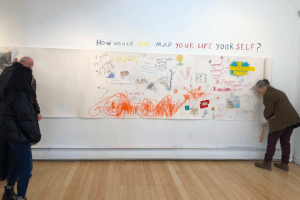By Emma Pierce Contributing Writer

“How Would You Map Your Life Yourself?” began as a blank scroll that viewers could add onto themselves. (Photo by Keely McConomy)
To start off the spring semester, the UMF Art Gallery has been hosting a collection of interactive works by Colby College alumni Maggie Libby entitled Across References since Feb. 7. The installation is staying until March 14.
Through her art Libby encourages the viewer to ask “provacative questions” about womens’ roles in history and how Maine’s geology may change over time.
“I have this duality of having a rich and wild New York art experience and then coming back to Maine with this isolation and poverty,” Libby said after explaining her time at the New York Studio School. “So this is why I want to think about, ‘What’s the real Maine? What’s the real Maine experience?’”
Libby hosted an “art talk” in the UMF Art Gallery on March 1. Art talks are lectures where the artist presents their art and the methods behind it in hopes of listeners gaining knowledge on different forms of art.
Though lectures can be influential, Libby invited the audience to engage in ways other than listening right away. “So much of my work is about trying to create a dialogue and interaction between object and viewer,” Libby said, “so I would love to make this a nontraditional [talk] and instead have it be a conversation.”
Libby presented strength to her audience of 20 in her opinions about womens’ roles in the art industry, the status of Maine’s environment, and her stance on her art. “Art is my medium,” she says. “So art is my voice.”
One of Libby’s pieces features the history of the Sandy River and its surrounding area, which she researched extensively. Libby mapped the Sandy River as a way to leads the viewer from her charcoal drawing of Saddleback Mountain to just before Farmington, mapping the Wabanoki tribe and other geologic features along the way.
Visitors have interacted similarly to another piece boldly titled, “HOW WOULD YOU MAP YOUR LIFE YOURSELF?” On the installation’s opening day, the piece was a blank scroll of paper spread across the gallery wall, but at Libby’s art talk the artist and participants helped Libby unroll the rest of the scroll to make room for more viewers’ art to be made.
Meadhdh Carroll, Creative Writing and English major, was struck by the significance of the concept of mapping a life. Carroll says Libby is trying to inspire change in her viewers. “It just seems like [she’s trying to ask], ‘what are you passionate about?’ or ‘what is something that you would fight for in your life?’” Carroll says.
Visitors have used materials, such as charcoal, maps and markers, provided by the gallery and Libby to become a part of Libby’s art, smearing words stenciled in charcoal and drew pictures on each of the pieces.
The gallery’s newest installation doesn’t only encourage those who draw. Libby has also made a box, some containing writing and others containing objects of different textures. “The other thing I love as a Maine resident is I love to look at the birds,” Libby says with a smile as she introduced her box containing housing insulation and birds, developing on her question of “What’s the real Maine experience?”
Libby’s installation also features portraits of women who have indirectly and directly influenced her life. Her passion for including women as a significant topic in her art was greatly influenced by the work she does as curator of the Colby College Archives’ visual resources. “In my life at the Archives, I realized that. . .women’s history is either nonexistent, lost, forgotten, or overlooked,” Libby says.
One of her pieces features five women who formed the first social protest at Colby College, focusing on the segregation of the school by biological sex. Libby produced it with a material that causes them to disappear, reflecting on what happens when we don’t speak up for what we want.
Carroll felt the importance of the inclusion of women in art. “When I look at the portraits of the women,” Carroll said, “I think of the impact that women have had on history. It’s very inspiring because. . .you’re looking at these portraits of these women that have changed so many people’s lives and it kind of seems like she’s trying to get that out of [the viewer].”
At the end of her art talk, Libby gave those who attended an assignment: “Think about how you can map or articulate or draw the boundaries of your life,” she says. After the art talk ended, the participants mapped their lives and chatted with Libby about art and its prescence in today’s world over coffee and snacks.
In a time when the campus is divided on issues that plague our university and our world, it is important that we find a way to express the anger, frustration, and need for change in ways that are not filled with malice intent. Across References came at just the right time.